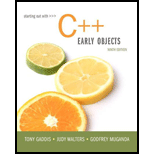
Starting Out with C++: Early Objects (9th Edition)
9th Edition
ISBN: 9780134400242
Author: Tony Gaddis, Judy Walters, Godfrey Muganda
Publisher: PEARSON
expand_more
expand_more
format_list_bulleted
Concept explainers
Expert Solution & Answer
Chapter 16.2, Problem 16.6CP
Explanation of Solution
Function template:
In C++, a function template is referred as a “generic” function, which can work with different data types.
- While writing a function template, a programmer should use a “type parameter” to denote a “generic” data type instead of using the actual parameter.
- The compiler generates the code, when it encounters a function call to a function template. This code will handle the particular data type which is used in the function call.
- The compiler indentifies the argument type and generates the code to work with those types.
- The generated code is referred as “template function”.
Example:
For example consider the following function template for finding a cube of value:
template <class T>
T cube(T x)
{
return x * x * x ;
}
- A function template must begin with the keyword “template” and it is followed by a pair of angle brackets, which contains one or more “generic” data types...
Expert Solution & Answer
Want to see the full answer?
Check out a sample textbook solution
Students have asked these similar questions
Using R language
using r language
using r language
Chapter 16 Solutions
Starting Out with C++: Early Objects (9th Edition)
Ch. 16.1 - Prob. 16.1CPCh. 16.1 - Prob. 16.2CPCh. 16.1 - Prob. 16.3CPCh. 16.1 - Prob. 16.4CPCh. 16.1 - Prob. 16.5CPCh. 16.2 - Prob. 16.6CPCh. 16.2 - The function int minPosition(int arr[ ], int size)...Ch. 16.2 - What must you be sure of when passing a class...Ch. 16.2 - Prob. 16.9CPCh. 16.4 - Prob. 16.10CP
Ch. 16.4 - In the following Rectangle class declaration, the...Ch. 16 - The line containing a throw statement is known as...Ch. 16 - Prob. 2RQECh. 16 - Prob. 3RQECh. 16 - Prob. 4RQECh. 16 - The beginning of a template is marked by a(n)...Ch. 16 - Prob. 6RQECh. 16 - A(n)______ container organizes data in a...Ch. 16 - Prob. 8RQECh. 16 - Prob. 9RQECh. 16 - Prob. 10RQECh. 16 - Write a function template that takes a generic...Ch. 16 - Write a function template that is capable of...Ch. 16 - Describe what will happen if you call the function...Ch. 16 - Prob. 14RQECh. 16 - Each of the following declarations or code...Ch. 16 - Prob. 16RQECh. 16 - String Bound Exceptions Write a class BCheckString...Ch. 16 - Prob. 2PCCh. 16 - Prob. 3PCCh. 16 - Sequence Accumulation Write n function T...Ch. 16 - Rotate Left The two sets of output below show the...Ch. 16 - Template Reversal Write a template function that...Ch. 16 - SimpleVector Modification Modify the SimpleVector...Ch. 16 - Prob. 8PCCh. 16 - Sortabl eVector Class Template Write a class...Ch. 16 - Prob. 10PCCh. 16 - Word Transformers Modification Modify Program...Ch. 16 - Prob. 12PC
Knowledge Booster
Learn more about
Need a deep-dive on the concept behind this application? Look no further. Learn more about this topic, computer-science and related others by exploring similar questions and additional content below.Similar questions
- I need help in explaining how I can demonstrate how the Laplace & Inverse transformations behaves in MATLAB transformation (ex: LIke in graph or something else)arrow_forwardYou have made the Web solution with Node.js. please let me know what problems and benefits I would experience while making the Web solution here, as compared to any other Web solution you have developed in the past. what problems and benefits/things to keep in mind as someone just learningarrow_forwardPHP is the server-side scripting language. MySQL is used with PHP to store all the data. EXPLAIN in details how to install and run the PHP/MySQL on your computer. List the issues and challenges I may encounter while making this set-up? why I asked: I currently have issues logging into http://localhost/phpmyadmin/ and I tried using the command prompt in administrator to reset the password but I got the error LOCALHOST PORT not found.arrow_forward
arrow_back_ios
SEE MORE QUESTIONS
arrow_forward_ios
Recommended textbooks for you
 C++ Programming: From Problem Analysis to Program...Computer ScienceISBN:9781337102087Author:D. S. MalikPublisher:Cengage Learning
C++ Programming: From Problem Analysis to Program...Computer ScienceISBN:9781337102087Author:D. S. MalikPublisher:Cengage Learning EBK JAVA PROGRAMMINGComputer ScienceISBN:9781337671385Author:FARRELLPublisher:CENGAGE LEARNING - CONSIGNMENT
EBK JAVA PROGRAMMINGComputer ScienceISBN:9781337671385Author:FARRELLPublisher:CENGAGE LEARNING - CONSIGNMENT C++ for Engineers and ScientistsComputer ScienceISBN:9781133187844Author:Bronson, Gary J.Publisher:Course Technology Ptr
C++ for Engineers and ScientistsComputer ScienceISBN:9781133187844Author:Bronson, Gary J.Publisher:Course Technology Ptr Systems ArchitectureComputer ScienceISBN:9781305080195Author:Stephen D. BurdPublisher:Cengage LearningProgramming Logic & Design ComprehensiveComputer ScienceISBN:9781337669405Author:FARRELLPublisher:Cengage
Systems ArchitectureComputer ScienceISBN:9781305080195Author:Stephen D. BurdPublisher:Cengage LearningProgramming Logic & Design ComprehensiveComputer ScienceISBN:9781337669405Author:FARRELLPublisher:Cengage

C++ Programming: From Problem Analysis to Program...
Computer Science
ISBN:9781337102087
Author:D. S. Malik
Publisher:Cengage Learning

EBK JAVA PROGRAMMING
Computer Science
ISBN:9781337671385
Author:FARRELL
Publisher:CENGAGE LEARNING - CONSIGNMENT

C++ for Engineers and Scientists
Computer Science
ISBN:9781133187844
Author:Bronson, Gary J.
Publisher:Course Technology Ptr

Systems Architecture
Computer Science
ISBN:9781305080195
Author:Stephen D. Burd
Publisher:Cengage Learning


Programming Logic & Design Comprehensive
Computer Science
ISBN:9781337669405
Author:FARRELL
Publisher:Cengage